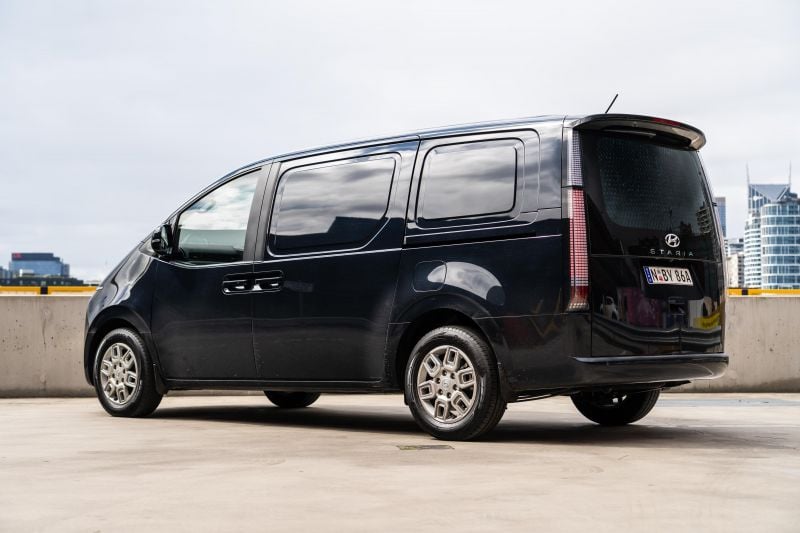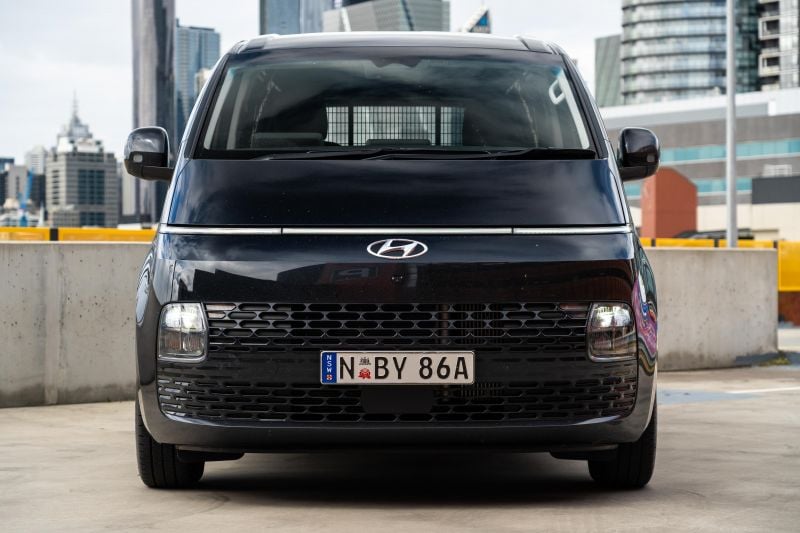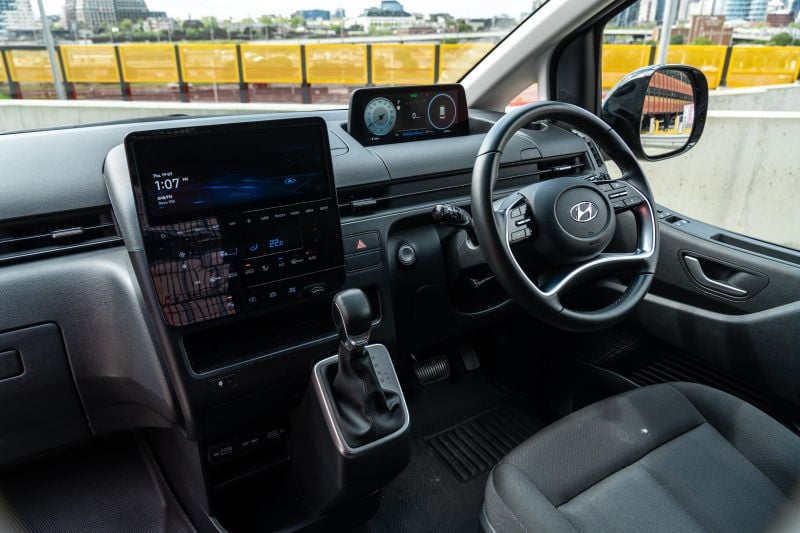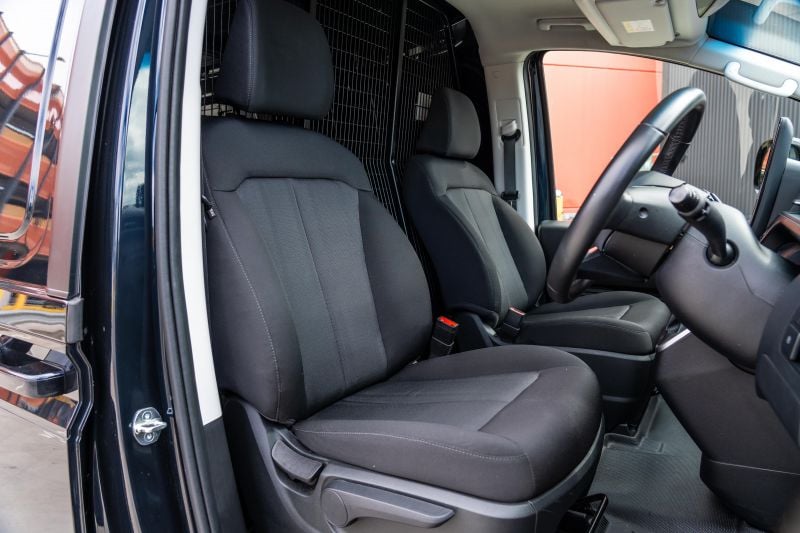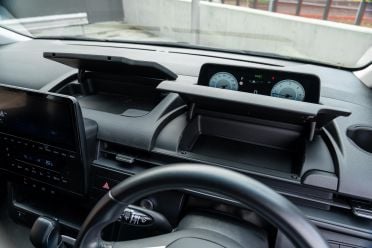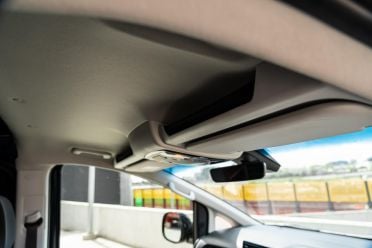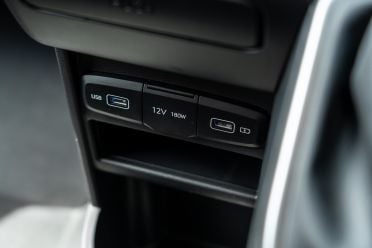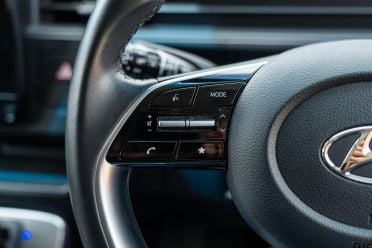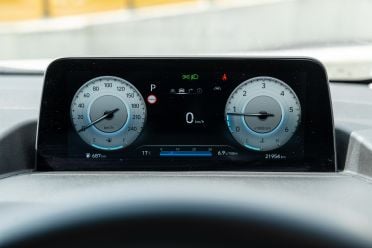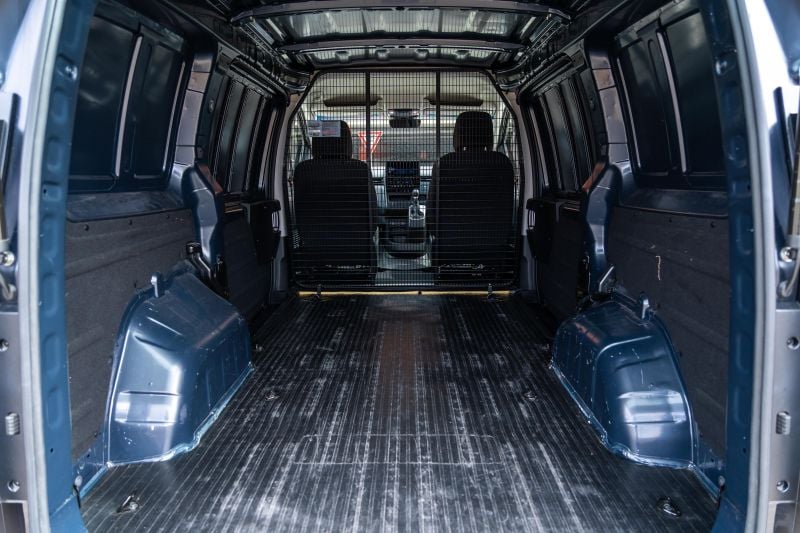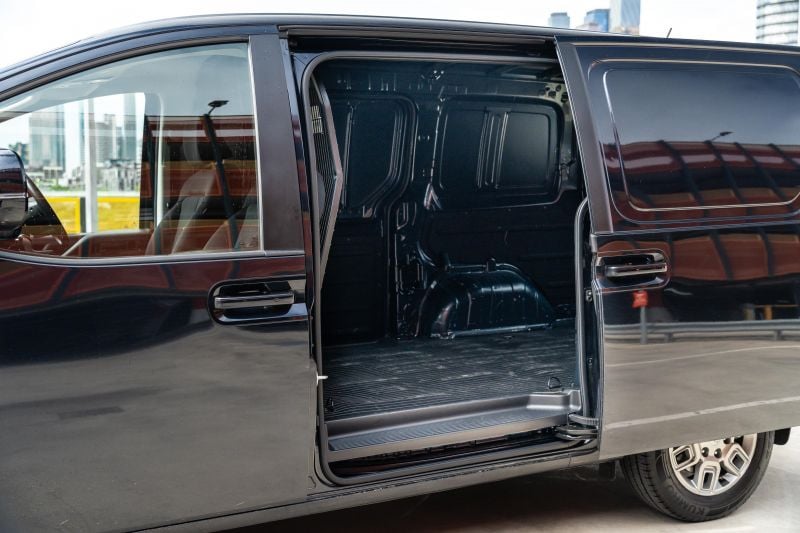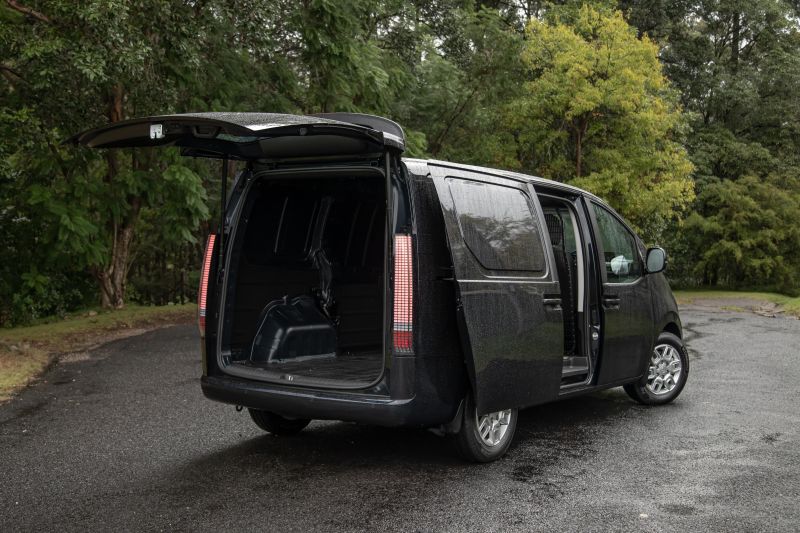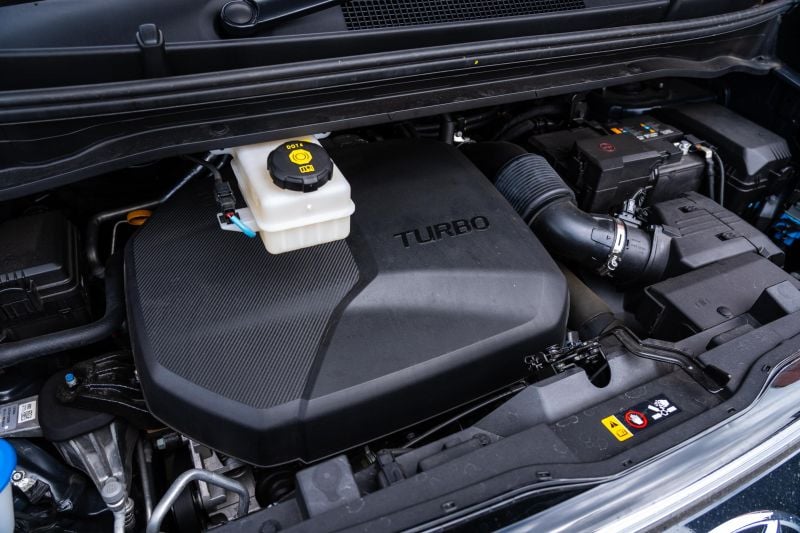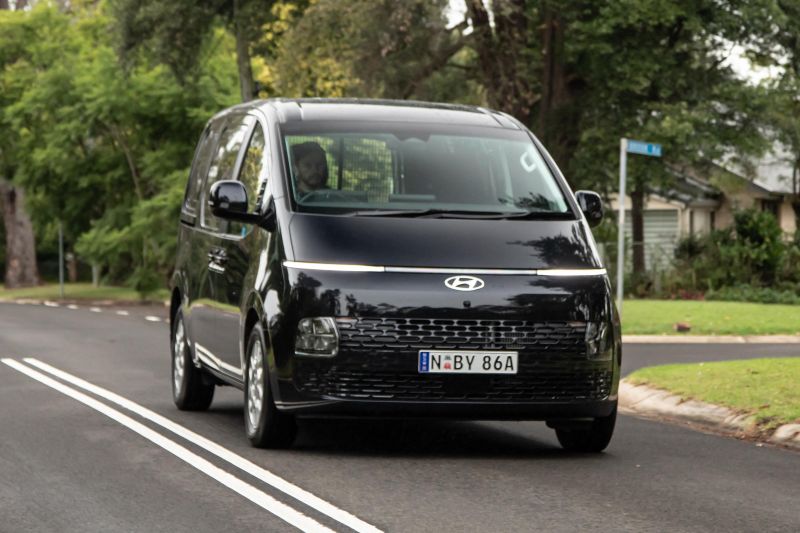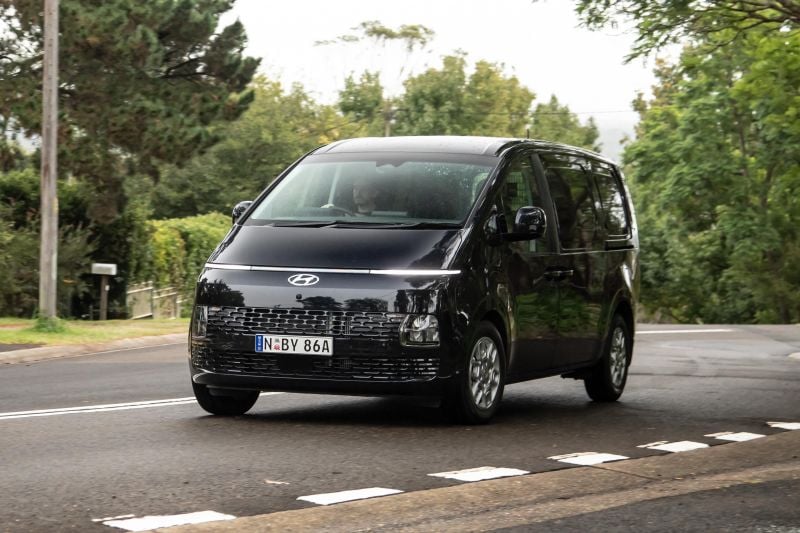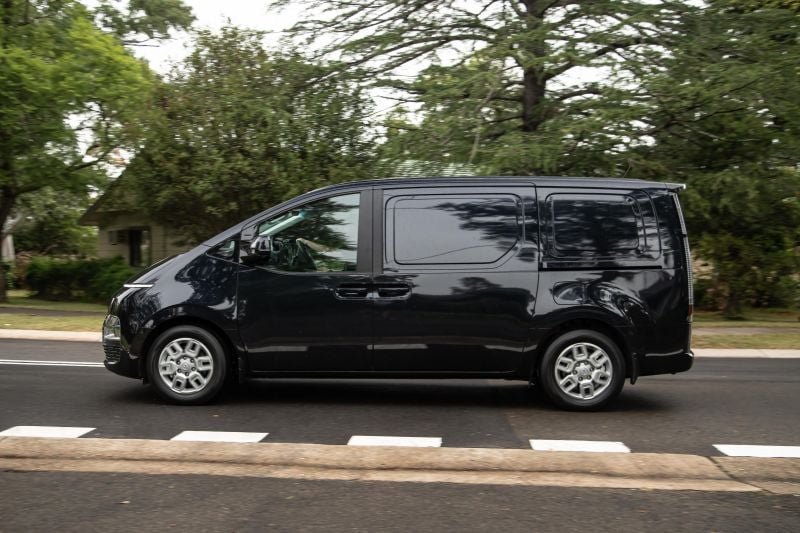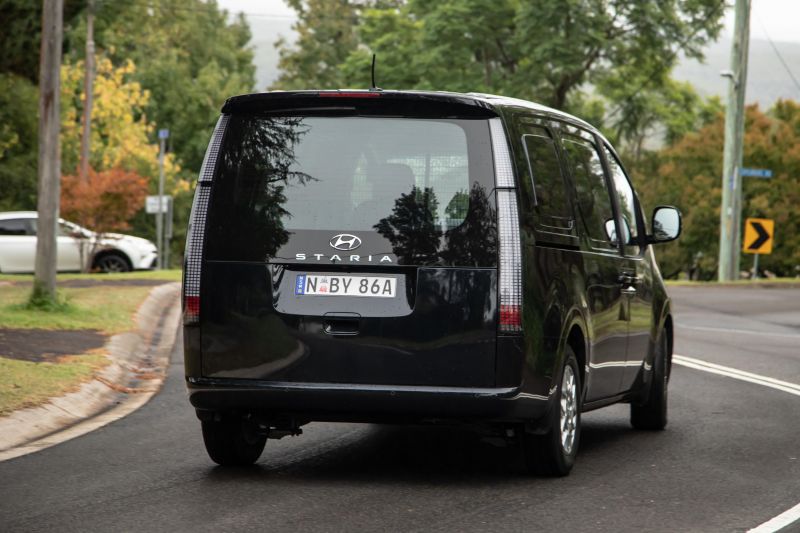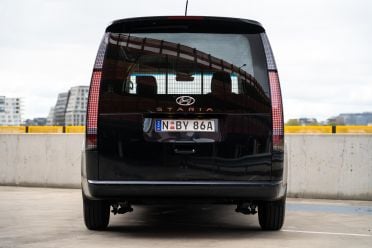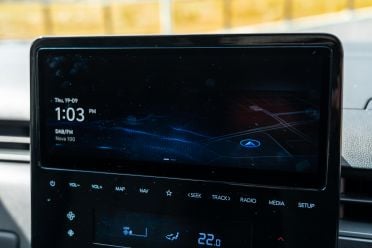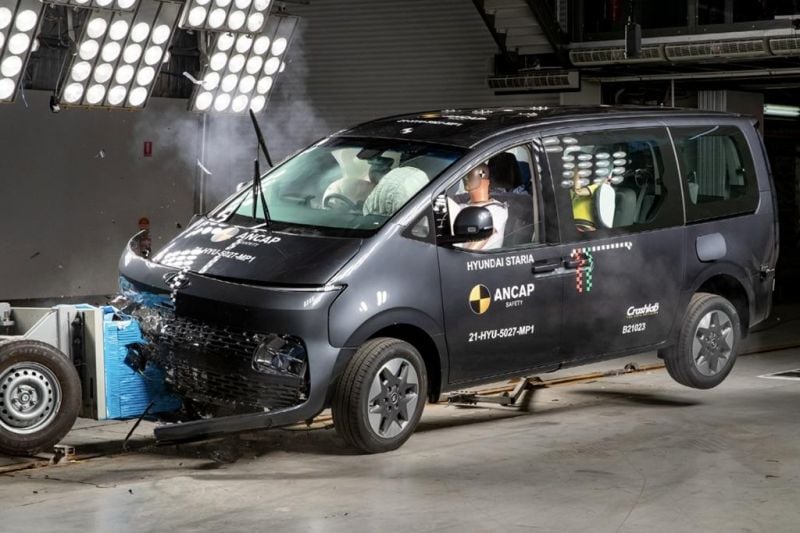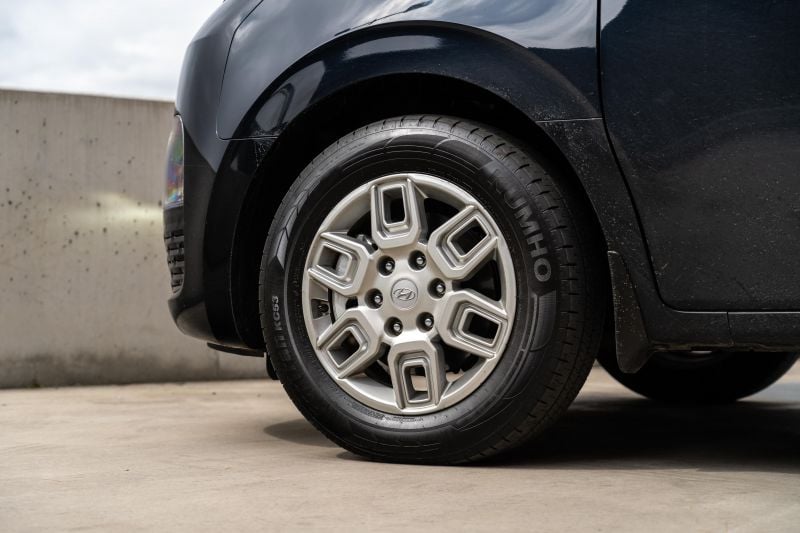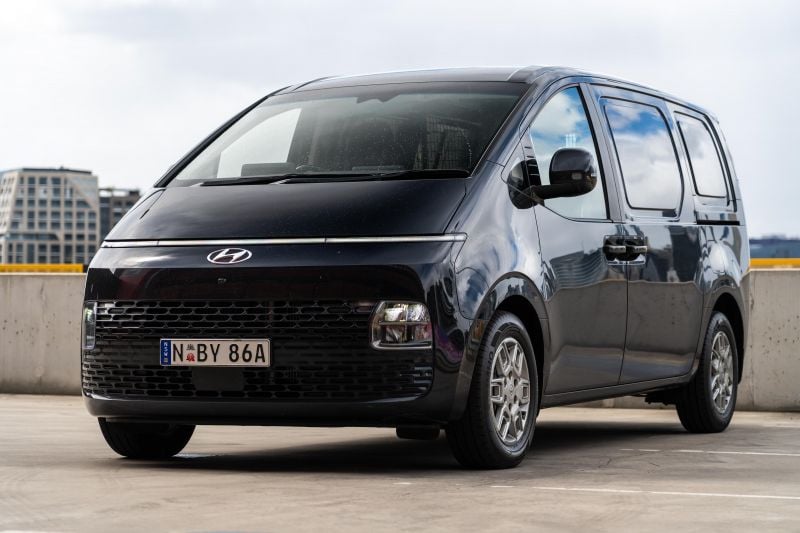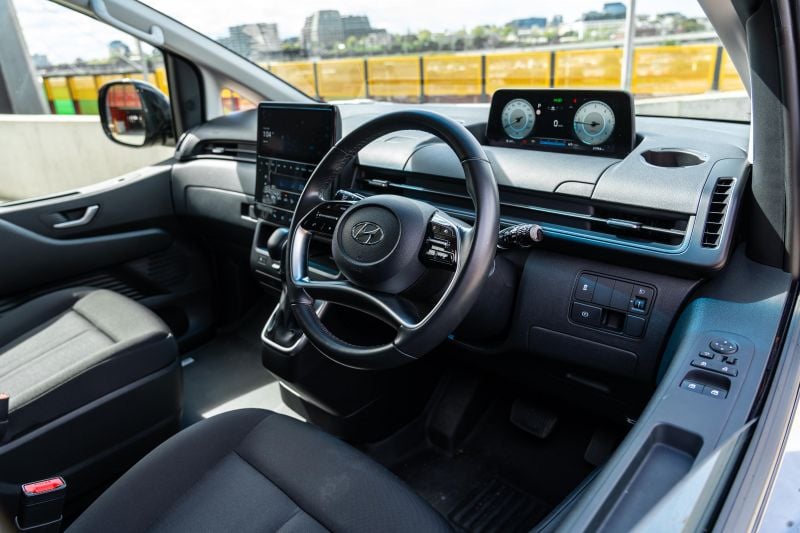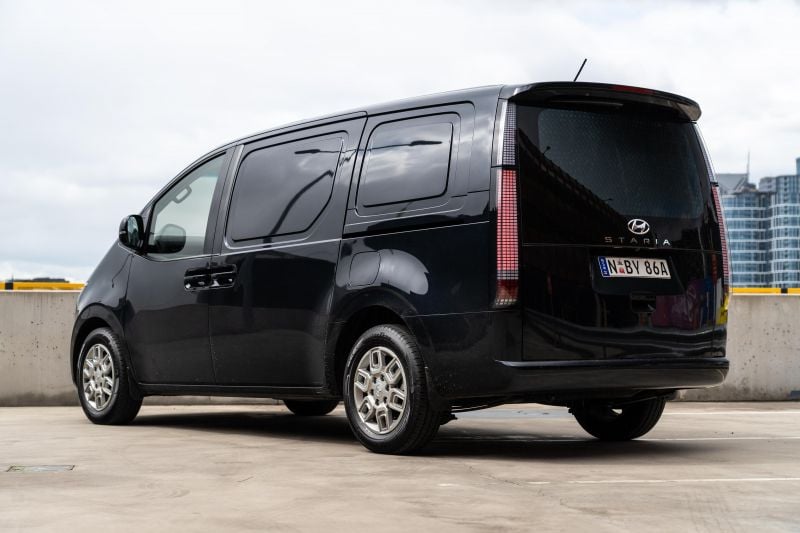Hyundai’s commercial hauler has polarising looks, but its practicality is hard to debate.
The Staria Load, like its related people mover namesake, the Staria, is a neat package from one of Australia’s most versatile brands.
There may not be performance or hybrid tech here, but what you do get is plenty of tech and features to keep you satisfied. A comfortable interior, quality infotainment, and agile steering are just a few things to get you interested; the rest you’ll learn about through some time behind the wheel.
Hyundai offers a large catalogue of genuine accessories too, which allows buyers to kit out their Staria Load with everything they need to improve the base package in their own specific way.
It all comes in at a competitive price too, matching the comparable Toyota HiAce and undercutting the new Ford Transit Custom.
WATCH: Paul’s video review of the Hyundai Staria Highlander
In 2023, the commercial Staria outsold the people mover variant at 2497 to 1141, selling in fewer units than only Hyundai’s best-selling passenger cars like the i30 and Tucson.
In the van world, it doesn’t quite match up to the rest. Rivals like the HiAce (7133), LDV G10 (3638), and Transit Custom (2843) all outsold the Staria Load in 2023, as it ranked ahead of only more expensive and obscure vans from European brands like Mercedes-Benz, Peugeot, and Renault.
Are you better off sticking with the crowd, or is the spaceship-style Staria Load the one you should be going for instead?

How much does the Hyundai Staria Load cost?
The top-spec Premium variant of the Staria Load range rings up at $51,740 before on-road costs – exactly $5000 up on the range-opening two-seater.
It’s more expensive than even the five-seat crew van, despite missing out on side windows and those additional seats. That price is before you start adding the extra Hyundai accessories fitted to our tester, which include a cargo barrier ($916.75), a heavy-duty rubber cargo floor mat ($762.75), and all-weather floor mats ($238.17).
Ours is also painted in Moonlight Blue, which like the other premium colours brings an additional cost of $695. That means if you want a Staria Load like the one you see here, expect to add nearly $3000 to the list price – and that’s before you consider on-road costs.
| Model | Price before on-road costs |
|---|---|
| 2025 Hyundai Staria Load two-seat van | $46,740 |
| 2025 Hyundai Staria Load five-seat crew van | $50,640 |
| 2025 Hyundai Staria Load Premium two-seat van | $51,740 |
Interested to see how the Hyundai Staria Load stacks up against our rivals? Use our comparison tool.
MORE: 2025 Hyundai Staria Load price and specs
What is the Hyundai Staria Load like on the inside?
While we’d stop short of calling it luxurious, there’s a lot to like about the Staria Load’s cabin.
The thing worth remembering with the Staria Load is that it is a commercial vehicle, and as such it’d be unreasonable to expect limousine-like comfort levels before getting behind the wheel.
Being the Premium grade, you do get some extra goodies like a larger infotainment display and digital instrument cluster, but as with the cheaper variants it’s headlined by its work-focused setup and barebones approach.
Such elements are evident in the materials used, which are all hard to the touch and utilitarian in appearance. The only soft-touch items you get are the large gear selector and steering wheel, the latter of which we’ve seen in other large Hyundai models like the Palisade.
I’m not the biggest fan of this steering wheel, but it does feel more at home here than it does in something like the Palisade. It’s wrapped in smooth, quality leather, and its size and angle are reminiscent of a small bus or an older Toyota HiAce van.
A quirk in the driving configuration is the seating position. From the comfortable cloth-trimmed seat you get a commanding view of everything around you, though it does lack armrests that would make the Staria Load that little bit more cruisy.
It also lacks three-person seating up front, though that means you’re able to make use of the space in the middle that’s otherwise occupied by a storage box in the five-seat crew van. The Staria Load’s layout is otherwise conventional, which means it takes no time to get used to.
What you may not be used to is having to look over the steering wheel to view the instrument cluster, because the display is mounted high atop the dash to make way for a hidden storage cubby.
It all works as intended, but you may need to take an extra second to get yourself adjusted accordingly if you’re a shorter individual. That generally won’t be an issue though, and it’s worth the compromise for the extra storage space it unlocks.
Ignoring the elephant in the van for the time being, Hyundai has been creative to implement as many storage options up front as possible.
There are two hidden storage cubbies on top of the dashboard for various odds and ends, as well as a more conventional glovebox ahead of the passenger seat. On the roof are also two storage shelves with elastic nets.
At the base of the centre console is another tub for loose items, and a cut-out for phone storage is found just above that. A wireless charging pad is located in a larger slot under the climate control panel, which also has plenty of space for other things like the key fob.
There’s also a singular cupholder on top of the dash on the driver’s side, which seems precariously close to the digital instrument display. Passengers can make use of the hidden cupholder on the centre console, which folds out when you press on its panel.
Storage is otherwise made up of space in the door cards and shallow cut-outs beneath the windows, while there’s a hidden compartment integrated into the driver’s side step for recovery gear.
Creature comforts in the Staria Load are kept to a minimum. There are no heated seats, power-adjustment, or digital rear-view mirrors to make use of; everything instead gets straight to the point.
The most complicated item is the climate and infotainment panel, which is populated by a plethora of touchscreen buttons and headlined by that 10.25-inch display. That display is nothing new for Hyundai models, and it looks great graphically with reliable functionality.
A downside to the larger screen is the lack of wireless Apple CarPlay from smaller-screen models, which means you’ll have to hook up your phone via cable instead.
Doing so is achieved via the USB-A port next to the gear selector, and there’s that convenient slot underneath for your phone to sit while plugged in.
The climate control panel is clearly legible thanks to its large icons, and its centre display helps to show what’s going on. There are shortcuts above for the various infotainment functions, and everything can be controlled via the buttons on the steering wheel.
Those steering wheel buttons all function as the should and worked reliably in our week with the van. They’re also the place to adjust things relating to appearance too, should you want to mess with the way the instrument cluster looks.
The gloss-black button material is a gripe, but it gives a more premium look in conjunction with the textured stalks behind.
It’s all clean and classy – Hyundai has struck a convincing balance between practicality and interior design in the Staria Load.
Displays on the instrument cluster are linked to drive mode, which can be toggled using the discreet button below the climate control interface.
There are three modes and appearances to cycle through, but you can lock it in a particular theme if you prefer one over the others.
Time to talk cargo. It’s a van, and the space you get in the back is largely as you’d expect.
Our tester was fitted with the optional rubber floor and cargo barrier, though we feel such items should be included as standard.
The floor protection helps to dampen noise and reduce the risk of scratches to the interior paint – much like what the panelling fitted to the walls as standard does.
The cargo barrier, which only works to keep cargo from sliding through, is nice to have even if it won’t keep the cabin’s climate isolated.
Having the optional solid barrier (or even the optional partition screen) would be preferable for passenger comfort and noise dampening, but this is better than nothing.
Space in the back of the Staria Load is quoted at 4.935 cubic metres, smaller than the HiAce at 6.2m3. Even so, it doesn’t feel compromised by any means.
Hyundai fits a sliding door on each side as standard (unlike Ford does with the Transit Custom), though being the Premium grade it misses out on a rear barn door option, something included on both the Toyota and Ford rivals.
You get the benefit of a powered tailgate instead, though it’s quite long when fully open. That means you get shelter from the rain, but you’ll struggle to load from the rear with a forklift, and you also won’t be able to open it if you reverse even remotely closely up to a wall.
The Staria Load makes up for it with sliding side doors, though their openings aren’t terribly wide.
On the inside you get eight tie-down points compared to the HiAce’s six, but only one light positioned on the roof above the tailgate. That makes it difficult to see if you’re using the side doors at night.
There’s only bare panelling on the roof, which echoes noise once on the road. It’s the same as what you find in a Transit Custom, though Toyota adds a roof liner and a central dome light to its HiAce.
The rear windows are protected by thick wire bars, and everything else is as it says on the box. It works well for the purpose it serves, though we suspect the rubber used in the optional floor contributed to the strange smell we were greeted with when stepping inside.
| Dimensions | Hyundai Staria Load Premium |
|---|---|
| Length | 5253mm |
| Width | 1997mm |
| Height | 2000mm |
| Wheelbase | 3273mm |
| Cargo bay length | 2607mm |
| Cargo bay width | 1640mm |
| Cargo bay height | 1436mm |
| Cargo bay volume | 4.935m3 |
| Payload | 1072kg |
| Kerb weight | 2002kg |
| Gross Vehicle Mass (GVM) | 3020kg |
| Towing capacity | 2500kg (braked) |
Interested to see how the Hyundai Staria Load stacks up against our rivals? Use our comparison tool.
What’s under the bonnet?
Unlike the Hyundai Staria people mover, there’s just one engine available for the Staria Load.
All three Staria Load variants share the same 2.2-litre four-cylinder turbo-diesel, which is mated with an eight-speed automatic transmission exclusively. Drive is sent to only the front wheels, unlike in the rear-drive HiAce.
| Specifications | Hyundai Staria Load |
|---|---|
| Engine | 2.2L 4cyl turbo-diesel |
| Power | 130kW @ 3800rpm |
| Torque | 430Nm @ 1500-2500rpm |
| Transmission | 8-speed automatic |
| Driven wheels | Front-wheel drive |
| Fuel economy – claimed | 7.0L/100km |
| Fuel economy – as tested | 6.9/100km |
| Fuel tank size | 75L |
| Fuel requirement | Diesel |
Interested to see how the Hyundai Staria Load stacks up against our rivals? Use our comparison tool.
How does the Hyundai Staria Load drive?
We say you shouldn’t expect too much in terms of comfort from a van, and the Staria Load is a good example of why.
Unladen, the ride is incredibly bouncy. Things that wouldn’t bother a typical car suddenly feel like small jump ramps, and you’ll find yourself going out of your way to avoid bumps and holes that could throw the van around.
That’s not to say it’ll become unsettled over larger bumps, but it can often be enough to catch you off guard. With a couple hundred kilograms worth of cargo loaded into the back it’s a different story, but if you’re often driving an empty van it can become difficult to live with.
While we had similar comments about the Transit Custom, it’s still true that the HiAce can manage its ride a lot better even when the load space is empty.
The Hyundai is quieter than the Toyota, at least compared to the bog-standard HiAce we recently drove with no interior options selected. Had they been comparably optioned, the noise battle may have turned out differently.
The bounciness isn’t helped by its wheels either, as although they’re a fairly standard size at 17-inches they feel (and look) far too small for such a large van.
Bumping up the wheel size an inch or two would make it look better, but would increase tyre replacement costs, worsen the bumpy-road ride and also come at the expense of on-road noise – which already isn’t great.
Still, it’s not all bad, and if you come into the Staria Load with a rough idea of what to expect there’s not much that will take you by surprise.
Once you’re past the initial bumps and bounces, this Hyundai turns out to be an enjoyable van to drive. It feels considerably taller than its rivals, and that helps to provide the high driving position it benefits from.
There’s also great visibility out front thanks to its sloped bonnet, and it’s a good middle ground between a typical passenger car and the vans of old in which the crumple zones were your knees.
Visibility is good out the side windows too, but that’s where the limitations start. As it’s a standard van with no side windows, physical blind-spot visibility is poor.
Hyundai makes up for it with the cameras fitted on each side, which project a live image to the instrument cluster when the corresponding indicator is activated. We’ve seen such tech in other Hyundai and Kia products before, and while it seemed superfluous there, we feel this is a much more practical application.
For comparison, Ford’s solution to the blind-spot issue is to fit a fisheye mirror to each side mirror housing, while Toyota has nothing beyond digital monitoring.
Ford and Hyundai supplement their blind-spot solutions with a monitoring system.
The performance of the Staria Load isn’t anything ridiculous, but it has no trouble getting up to speed in a hurry.
Low-end torque is strong enough to get it out of most sticky situations, and when there’s nothing in the back it can be quite spritely and agile. Surprising given its dimensions, but it makes it even better as a run-around in built-up areas.
The eight-speed automatic transmission is well-behaved and almost never caught in the wrong gear, with smooth shifts and a quick response its headlining characteristics.
Hyundai has made the driving experience as easy as possible from a handling perspective too, as the Staria Load boasts light steering and a tight turning circle to make up for its size.
If you’re a commercial vehicle buyer who needs the Staria Load for transport and logistics, it’s good to have that manoeuvrability for the various tight spaces you may find yourself in.
The Staria Load is fitted with adaptive cruise control with lane centring as standard, and it worked reliably in our week with the van. There wasn’t a tendency to stray out of its lane, and steering inputs were consistent and smooth.
Longer drives on the freeway were made easy as a result, especially if you avoided changing lanes as much as possible because of those blind-spot limitations.
Downsides include its headlights, which we feel could be a bit brighter. Its high-beams worked fine, but in unlit areas it’s not quite as bright as we’re used to. You do get the benefit of the LED light bar across the front, which provides greater visibility for other road users.
Another was the road noise, which was especially bad on wet roads. As it isn’t a passenger vehicle, that isn’t a deal-breaker, and it’s manageable if you’re fine with a bit of extra volume.
Interested to see how the Hyundai Staria Load stacks up against our rivals? Use our comparison tool.
What do you get?
There are three grades of Staria Load, each with a handful of key features to set them apart.
Staria Load standard equipment:
- Choice of Liftback or Twin Swing rear doors
- Halogen headlights
- 17-inch steel wheels
- Full-sized spare
- Heated, power-folding exterior mirrors
- Cloth upholstery
- 8.0-inch touchscreen infotainment system
- Wireless Android Auto and Apple CarPlay
- Wireless phone charging
- USB-C port
- Leather-wrapped steering wheel and shifter
The Crew Van receives a centre console storage box, a three-seat second-row bench, second-row windows and two more USB-C ports.
Staria Premium (liftback only) adds:
- LED headlights
- LED tail lights
- Automatic high-beam
- Rain-sensing wipers
- 17-inch alloy wheels
- 10.25-inch touchscreen infotainment system
- Satellite navigation
- Wired Android Auto and Apple CarPlay
- 10.25-inch digital instrument cluster
- Blind-Spot View Monitor
- Keyless entry and start
- Power tailgate
- Bluelink connected services
- Remote control of climate and vehicle functions
- Vehicle settings management
- Live traffic updates
- Navigation send to car
- Voice recognition for POI lookup, vehicle controls
Is the Hyundai Staria Load safe?
The Hyundai Staria Load has a five-star safety rating from ANCAP, based on testing of the related people mover conducted in 2021.
| Category | Hyundai Staria |
|---|---|
| Adult occupant protection | 85 per cent (32.38 out of 38) |
| Child occupant protection | N/A |
| Vulnerable road user protection | 65 per cent (35.37 out of 54) |
| Safety assist | 74 per cent (11.90 out of 16) |
Standard safety equipment includes:
- 7 airbags incl. front-centre
- Autonomous emergency braking
- Pedestrian, cyclist detection
- Junction-turning assist
- Blind-spot monitoring
- Rear cross-traffic assist
- Lane keep assist
- Lane Following Assist (lane centring)
- Adaptive cruise control with stop/go
- Surround-view camera (liftback only)
- Leading vehicle departure alert
- Driver attention warning
- Intelligent speed limit assist
- Front and rear parking sensors
- Safe exit warning
While previous Starias featured blind-spot assist as standard, the 2025 model has reverted to an alarm-only system.
The Staria Load Premium adds a blind-spot view monitor, as well as the model debut of Hyundai’s Bluelink connectivity, which includes automatic collision notification, emergency call (SOS) function and alert services including geo-fencing, valet, speed and time alerts.
How much does the Hyundai Staria Load cost to run?
The Hyundai Staria Load is backed by a five-year, unlimited-kilometre warranty, with servicing required every 12 months or 15,000km, whichever comes first.
| Running costs | Hyundai Staria Load |
|---|---|
| Warranty | Five-year, unlimited-kilometre |
| Roadside assistance | 12 months free, then service-activated |
| Service intervals | 12 months or 15,000km |
| Capped-price servicing | Lifetime Service Plan |
| Total service cost – 5 years | $2375 – Pre-Paid Servicing |
Interested to see how the Hyundai Staria Load stacks up against our rivals? Use our comparison tool.
CarExpert’s Take on the Hyundai Staria Load Premium
If you’re in need of a van, the Staria Load is one worth considering.
It may not be as iconic as something like a HiAce or as stylish as the new Transit Custom, but if you’re after strong cargo capacity in a comfortable package, the Staria Load has plenty to offer.
Its interior tech is great, even without wireless smartphone mirroring, and the cabin is well-enough appointed to keep you interested without going over the top.
The driving tech works reliably and never becomes intrusive either, which is more than can be said for many other Hyundai and Kia products.
Hyundai’s diesel engine is a strong unit too, and when mated with a reliable gearbox it makes for an enjoyable drive – even if it can be a bit bouncy with nothing in the back.
Ride quality does leave a bit to be desired, and if you need to transport more than one passenger you’re going to struggle with the lack of a middle seat.
The options fitted to our tester, including the cargo barrier, are things that should be included as standard, because we feel they’re van must-haves. Driving around with cargo sliding into the front cabin isn’t ideal, and it’s a lot of space to heat in winter.
It also lacks the practicality of rear barn doors, and for a top-spec model it’d benefit from something like powered sliding side doors. Wireless Apple CarPlay would also complement that large infotainment display nicely.
But as a van made to transport cargo and be comfortable for long hours on the road, the Staria Load does well. It may not be our first choice, but as a rival to other well-established van nameplates it’s a worthy contender.
Interested in buying a Hyundai Staria Load? Get in touch with one of CarExpert’s trusted dealers here.
Click the images for the full gallery





